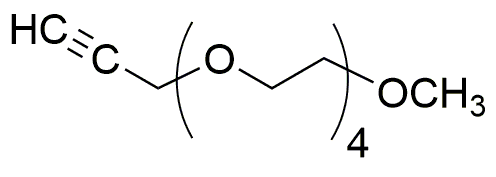2,5,8,11,14-Pentaoxaheptadec-16-yne is widely utilized in research focused on:
- Polymer Chemistry: This compound serves as a building block for creating advanced polymers with enhanced properties, such as flexibility and durability, making it valuable in the production of coatings and adhesives.
- Biomedical Applications: Its unique structure allows it to be used in drug delivery systems, where it can improve the solubility and bioavailability of therapeutic agents, thus enhancing their effectiveness in medical treatments.
- Surface Modification: The compound is effective in modifying surfaces to improve hydrophilicity or hydrophobicity, which is crucial in industries like textiles and electronics for better performance and longevity of materials.
- Nanotechnology: It plays a significant role in the synthesis of nanoparticles, which are essential in various applications, including catalysis and environmental remediation, due to their high surface area and reactivity.
- Cosmetic Formulations: The compound is incorporated into cosmetic products for its emulsifying properties, helping to stabilize formulations and enhance the texture and feel of creams and lotions.
General Information
Properties
Safety and Regulations
Applications
2,5,8,11,14-Pentaoxaheptadec-16-yne is widely utilized in research focused on:
- Polymer Chemistry: This compound serves as a building block for creating advanced polymers with enhanced properties, such as flexibility and durability, making it valuable in the production of coatings and adhesives.
- Biomedical Applications: Its unique structure allows it to be used in drug delivery systems, where it can improve the solubility and bioavailability of therapeutic agents, thus enhancing their effectiveness in medical treatments.
- Surface Modification: The compound is effective in modifying surfaces to improve hydrophilicity or hydrophobicity, which is crucial in industries like textiles and electronics for better performance and longevity of materials.
- Nanotechnology: It plays a significant role in the synthesis of nanoparticles, which are essential in various applications, including catalysis and environmental remediation, due to their high surface area and reactivity.
- Cosmetic Formulations: The compound is incorporated into cosmetic products for its emulsifying properties, helping to stabilize formulations and enhance the texture and feel of creams and lotions.
Documents
Safety Data Sheets (SDS)
The SDS provides comprehensive safety information on handling, storage, and disposal of the product.
Product Specification (PS)
The PS provides a comprehensive breakdown of the product’s properties, including chemical composition, physical state, purity, and storage requirements. It also details acceptable quality ranges and the product's intended applications.
Certificates of Analysis (COA)
Search for Certificates of Analysis (COA) by entering the products Lot Number. Lot and Batch Numbers can be found on a product’s label following the words ‘Lot’ or ‘Batch’.
*Catalog Number
*Lot Number
Certificates Of Origin (COO)
This COO confirms the country where the product was manufactured, and also details the materials and components used in it and whether it is derived from natural, synthetic, or other specific sources. This certificate may be required for customs, trade, and regulatory compliance.
*Catalog Number
*Lot Number
Safety Data Sheets (SDS)
The SDS provides comprehensive safety information on handling, storage, and disposal of the product.
DownloadProduct Specification (PS)
The PS provides a comprehensive breakdown of the product’s properties, including chemical composition, physical state, purity, and storage requirements. It also details acceptable quality ranges and the product's intended applications.
DownloadCertificates of Analysis (COA)
Search for Certificates of Analysis (COA) by entering the products Lot Number. Lot and Batch Numbers can be found on a product’s label following the words ‘Lot’ or ‘Batch’.
*Catalog Number
*Lot Number
Certificates Of Origin (COO)
This COO confirms the country where the product was manufactured, and also details the materials and components used in it and whether it is derived from natural, synthetic, or other specific sources. This certificate may be required for customs, trade, and regulatory compliance.

